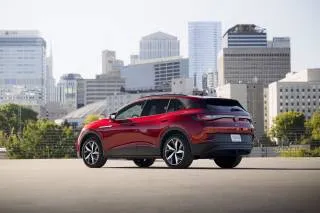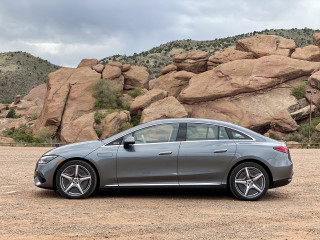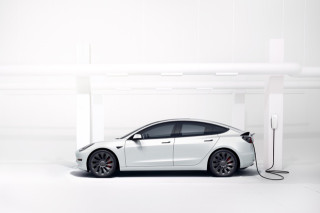Likes
- Quiet ride
- Loaded standard features
- Luxury-like options
- Roomy sedan
- Efficient
Dislikes
- Price?
- EPA range?
- Trim levels?
- Dual-motor performance?
- Bidirectional charging not in U.S.
Buying tip
The 2025 Volkswagen ID.7 premium sedan drives like a touring sedan and offers luxury-like features.
What kind of vehicle is the 2025 Volkswagen ID.7? What does it compare to?
The new VW ID.7 is a fastback sedan that nudges the brand into the premium segment. It’s longer than the gas-powered Volkswagen Arteon flagship sedan, and has a wheelbase that’s an inch longer than the Hyundai Ioniq 6 sedan for a much roomier interior. It’s sized more like a Tesla Model S than a Model 3, and distantly related to the ID.4 compact crossover in the VW family.
Is the 2025 VW ID.7 a good car?
We’re awaiting crash-test results, trim features, and pricing for VW’s electric sedan, but the efficiency, technology, and propulsion system represent an evolution over the first iteration of the ID electric family. For now, it earns an incomplete TCC Rating of 8.3 out of 10. (Read more about how we rate cars.)
What's new for the 2025 Volkswagen ID.7?
The 2025 VW ID.7 is a new electric sedan that builds off the ID.4 compact crossover and other ID vehicles in VW’s electric family with more powerful motors, a larger battery pack option, and the latest iteration of VW’s infotainment system.
If not for the prominent VW badging on the front and rear ends, the ID.7 sedan could be mistaken for an Audi A7 due to the fastback roofline. If not for the light bar bowing over a solid front grille, the ID.7 could be mistaken for a new Arteon flagship sedan, but longer, sleeker, and glinting with an aerodynamic design intended for efficiency. The inside shines with a new 15.0-inch touchscreen and a spartan layout with an available fixed glass roof that reflects the open and airy cabin.
Below the raised floor is an 82-kwh battery pack (77 kwh net) used in the ID.4, but it can fit a larger 85-kwh net pack that will be sold in Europe. The pack feeds a new permanent magnet rear motor with more windings and stronger magnets to make 282 hp and 429 lb-ft of torque, good for a 0-60 mph time of 6.5 seconds, according to VW. A dual-motor all-wheel-drive model will also be offered, but our impressions are limited to the single-motor model. It’s quick enough for effortless passing, if not for breathtaking acceleration off the line, but the charm in the ID.7 is its quiet, serene ride with an independent suspension and available active dampers that soak up all sorts of upheaval from the road.
It seats up to five, but four in comfort, especially with standard heated and powered front seats that can be equipped with massagers to extend the comfort for all of its projected 350-mile range. Rear-seat passengers have crossover-like space with ample headroom and legroom, and even though the deep hatch houses up to 18.8 cubic feet of stuff, a pass-through enables long item storage such as a set of golf woods for the foursome.
How much does the 2025 Volkswagen ID.7 cost?
VW hasn’t detailed trim levels, standard safety equipment, or pricing, but standard gear includes 15.0-inch touchscreen with an improved climate interface, a head-up display effectively replacing the traditional gauge cluster, heated front seats, a heated steering wheel, ambient lighting, keyless start, and 19-inch alloy wheels.
It’s likely the North American ID.7 gets the same standard driver-assist features as the European model. That includes a surround-view camera system, automatic emergency braking with pedestrian and cyclist detection, and adaptive cruise control, to name a few.
If VW offers the same standard content here, it will succeed in positioning the ID.7 as a premium electric sedan.
Where is the 2025 Volkswagen ID.7 made?
In Emden, Germany.
2025 Volkswagen ID.7 Styling
The 2025 Volkswagen ID.7 stretches out its fastback sedan shape.
Is the VW ID.7 a good-looking car?
It’s understated but handsome, in the conservative Volkswagen way. A long roofline tapering into the hatch accentuates wheels that creep toward the edges for a stately profile that earns it a point. A spartan interior crowned by an improved 15.0-inch touchscreen and very little else earns another point to a 7.
At 195.3 inches long and with a wheelbase of 117 inches, it’s nearly as long as a Tesla Model S or Mercedes EQE, and nearly four inches longer than an Arteon, which itself was longer than a Passat. It’s also nearly four inches taller than the Arteon, so even though it looks like a sedan it rides a bit higher so you’re not eye level with the door handles on all the trucking SUVs on the road. The tapered fastback roofline enables a low coefficient of drag of 0.23, and the chrome window line gives it a premium edge.
Its premium ambitions and electric DNA take hold inside. A low dash and a thin recessed band of vents open up the windshield for a better view of the standard head-up display that all but replaces the traditional instrument cluster. This results in wide open space topped by a glass roof and stretched to the edges with slender chrome door handles on textured dash and door materials. The microsuede on the armrests might take a beating, but the most notable interior design element is the one you don’t see most often. A blue light bar where the dash meets the windshield appears when the navigation is set, and will blink left to right if you need to get over for a ramp, or pulse blue on the right side if you need to make a right turn. It’s discrete but acts as a third reminder beside the nav display in the touchscreen or the commands in the head-up display.
2025 Volkswagen ID.7 Performance
The ID.7’s quiet and composed character breathes new life in the electric sedan.
Composed handling and pert acceleration each earn a point to give the 2025 Volkswagen ID.7 a 7, natch.
Is the ID.7 4WD?
The ID.7 arrives in North America in the second half of 2024 with both a single-motor model and a dual-motor all-wheel-drive option. Our driving impressions are limited to the single-motor rear-wheel-drive model, for now.
How fast is the VW ID.7?
The ID.7 debuts a new, more powerful permanent magnet motor for the ID family of electric vehicles. It has more windings and stronger magnets than the ID.4, and it’s both air- and water-cooled. Rated at 210 kw, it makes 282 hp and 429 lb-ft of torque, up from 201 hp and 229 lb-ft in the ID.4, and boosts the 62 mph time to 6.5 seconds. It tops out at 112 mph, which may be a German problem on the Autobahn more than an American one. All that torque requires a new reduction gear, and a new inverter as well as additional cooling improve efficiencies and reduce frictional losses.
From a dead stop, a surge of full torque gets arrested momentarily before dashing ahead. It’s more spirited than the ID.4, but it lacks the sudden burst of power common in more powerful EVs. There’s ample power for uphill passing, and it stays in character of the touring car by being serene and quiet while cruising, but responsive when called upon.
Drivers can tap into four modes in Eco, Comfort, Sport, and Individual that stiffens the accelerator response in Sport and turns it to mush in Eco. Sport mode also tightens the steering feel and firms up the available adaptive dampers. The differences are more subtle than pronounced, and a layered menu system can let you customize it in Individual mode.
A 77-kwh battery pack (82 kwh gross) feeds the motors, and the ID.7 should have a range of about 350 miles, though that hasn’t been certified by the EPA as of press time. The ID.7 can’t charge as fast as the Hyundai Ioniq 6 and doesn’t have bidirectional charging yet. DC fast-charge times at an output of 175 kw can fill the battery pack from 10 to 80% in 28 minutes, which is 10 minutes slower than the Ioniq 6 and its superior 800-volt electrical architecture. It also has an 11.0-kw onboard charger for 240-volt home charging.
There’s only one regen brake setting, set to B on the gear stalk on the column. It’s not grabby enough to make the car pull when you let off the accelerator pedal, but it’s strong enough to allow VW to slap basic drum brakes on the rear wheels. Most of the braking happens up front and through the motor, and VW claims there’s less rolling resistance with drums than with disc brakes.
How does the ID.7 handle?
The ID.7 is built for comfort. VW doesn’t offset its 4,788-pound curb weight with an air suspension, instead relying on front struts and a multilink rear suspension supplemented with available adaptive damping. The large high-riding sedan feels more connected to the road than most other electric crossovers or hatchbacks.
The suspension tune avoids nosedive under heavy braking, and even though driving hard into corners can nudge you in the seat, it’s never enough to tip you into the door. Hefty steering feel gets progressively tighter in Sport mode but the drive modes and granular modulations don’t move it much from its true nature of being a fine touring sedan, quiet, comfy, and with enough power to escape traffic. If seeking more potency, wait for the dual-motor GTX model.
2025 Volkswagen ID.7 Comfort & Quality
A roomy cabin extends to a long hatch in the VW ID.7.
With a 117-inch wheelbase that’s about the same size as the Volkswagen Atlas three-row crossover SUV, the ID.7 adopts an open and roomy floor plan particular to electric vehicles. Comfy bucket seats with standard power and heating, as well as roomy rear seats and a hatch that’s deeper than most crossovers, each earn it a point, as does a silent and cushioned ride quality that nudges it into the premium class. It’s a 9.
The rounded roofline and standard glass roof don’t lop off heads in the spacious back seats of the Volkswagen ID.7. At 5-foot-8, I could stack a fist on my head and it didn’t hit the roof. Two adults fit comfortably in the back, with the middle seat best used as a cupholder or as a pass-through to the hatch. The 60/40 split seats fold down simply from the seat tops or from a latch in the hatch, expanding cargo room from 18.8 cubic feet to a crossover-like 56.0 cubic feet of space. The load floor is flat, or it can be lowered to optimize the vertical space. The rearmost portion behind the axle has additional storage as well.
The most surprising thing about the ID.7 is how isolated it is from the passing world. Tire and road noise don’t intrude until speeds of about 70 mph, and even then it’s muted. The fit and finish affirms VW’s premium ambitions.
2025 Volkswagen ID.7 Safety
A comprehensive suite of standard safety features grace the tech-forward ID.7.
How safe is the Volkswagen ID.7?
The NHTSA and the IIHS haven’t crash tested the large sedan yet, but VW equips it with an expansive suite of driver assist technology intended to help drivers avoid crashes. Standard on the ID.7 Pro are a surround-view camera system, automatic emergency braking with pedestrian and cyclist detection, active lane control, adaptive cruise control, traffic sign recognition, blind-spot monitors, park assist, an exit warning system, and a driver attention monitor. It’s a remarkable bundle of advanced driver assist systems, and is standard for the German market. We’ll update this once we know the U.S. spec.
Optional features include a limited hands-free driving system with clear iconography and easy operation. The navigation directions appear in the head-up display, as well as on the touchscreen and in a discrete blue light bar in the cowl. This triple reminder never overwhelms and does a great job of keeping the driver on track.
The low dash and broad windshield makes for great outward vision and unlike other fastback sedans, the view out of the rear windshield isn’t so pinched as to obfuscate the blind spots.
2025 Volkswagen ID.7 Features
Pricing has not been announced, but the 2025 VW ID.7 comes well equipped.
If the North American version comes as well equipped as the base ID.7 Pro launching in Germany, then Volkswagen will have succeeded in creating a premium large sedan that’s more luxurious than the Arteon. Standard features include 19-inch alloy wheels, LED head- and taillights, ambient lighting, three-zone climate control, heated steering and heated front seats, keyless locking and access, and a wireless smartphone charger.
We can’t assign it a Features rating until we know the trims, pricing, and overall value.
Which VW ID.7 should I buy?
Good question. The ID.7 Pro sounds very compelling. Every ID.7 will likely come with a 15.0-inch touchscreen with an improved layout and updated infotainment system. It corrects most of the bugaboos of the touch-sensitive infotainment and climate sliders that launched with the ID.4. The climate sliders below the touchscreen are backlit and easier to slide your finger across while driving, but it’s easier still to press it down for incremental temperature changes.
The touchscreen itself has much larger, clearer iconography, and the navigation display is easy to load and follow. A configurable top bar and climate lower bar act as hot buttons so you don’t have to scroll through menus.
The head-up display comes standard, as well, because VW minimized the instrument cluster and vital driving info to a small rectangle the size of a candy bar. The augmented reality head-up display works well as a more advanced gauge substitute but the blue lines in the flashing navigation guidance can get washed out while wearing polarized sunglasses.
How much is a fully loaded VW ID.7?
We expect it to top out between $60,000 and $70,000. One feature we loved were the ergoActive front bucket seats that not only blend heating, cooling, and power functions, but the massagers come with dozens of settings for type, duration, and intensity, and transform the ID.7 into a luxury tourer. Other options include Harmon Kardon sound and a fixed glass roof with power tinting.
2025 Volkswagen ID.7 Fuel Economy
Expect a range of about 350 miles in the Volkswagen ID.7.
Is the Volkswagen ID.7 good on energy?
Yes. The ID.7’s aerodynamic design and low 0.23 coefficient of drag, as well as its more efficient ID motor, help to optimize the 77-kwh battery pack (82 kwh gross) for a range of about 350 miles for the single-motor model. The EPA has not certified it yet. A larger 85-kwh battery pack may arrive in late 2024.
If the ID.7 does this well in official EPA range ratings, it would be among the most efficient electric cars, alongside the Hyundai Ioniq 6 and Tesla Model 3.















































































